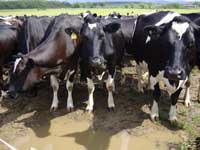Disease check: Infectious bovine rhinotracheitis

Learn how to tackle infectious bovine rhinotracheitis (IBR) as part of Farmers Weekly’s disease check series.
Symptoms
IBR is a significant cause of pneumonia and mortality in weaned beef calves, says vet Robert Anderson, Merlin Vet Group.
The problem is, when a cow is exposed to IBR, it may fight off infection, but it will always have the potential to shed the disease during times of stress.
And because of this, problems associated with IBR are commonly experienced within a fortnight of weaning and/or housing in un-vaccinated beef herds, he says.
Calves will often appear dull and depressed and will run a persistent high temperature. “IBR will often present itself in the form of pneumonia type symptoms – a difficult -to-treat pneumonia case may be an indicator of IBR.”
IBR causes respiratory disease in stock of any age, high temperatures and runny nose and eyes, says vet Den Leonard, Lambert, Leonard and May.
“In adult dairy cows, symptoms may not be that pronounced, with cows typically showing a high temperature and reduced milk yields.”
How is it spread?
IBR is caused by the herpes virus which is excreted from the nose and airways and can be spread through air and via feed sharing, explains Mr Leonard.
The risk of buying in IBR is high, so all bought in stock should be vaccinated at purchase, stresses Mr Anderson.
“A cow may have been infected with the disease as a calf, but she may be an ‘asymptomatic carrier’ as an adult, i.e. she is not displaying any clinical signs.”
In this way, replacement heifers may be a source of infection – potentially passing the disease on to their calf.
Intervet/Schering Plough data show 67% of dairy herds and 51% of beef herds tested had evidence of IBR exposure. Although not all animals show clinical signs, it is essential to be aware of its existence.
IBR can also be spread by semen, placing a strong emphasis on knowing the disease status of bought in bulls for good biosecurity.
A bull may be IBR negative at sale, but if he is sold into an IBR positive herd, sperm quality could be affected when exposed to the disease virus, explains Mr Anderson.
Testing and control
Nasal swabs can help identify the problem but, because the test is not 100% accurate, I would recommend vaccinating when IBR is suspected, says Mr Leonard.
And because carriers may be asymptomatic, continuing a vaccination programme is key. “When a vaccination programme is stopped and there are still carriers present, the problem will reoccur – continuous vaccination will help eliminate the problem.”
When IBR is diagnosed in beef herds, calves should be vaccinated and all weaned calves should be vaccinated as standard at housing, Mr Anderson continues.
For more from the our disease check series click here.
